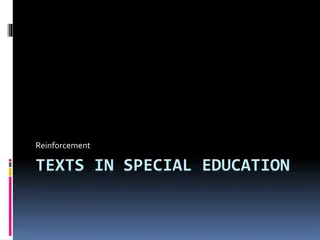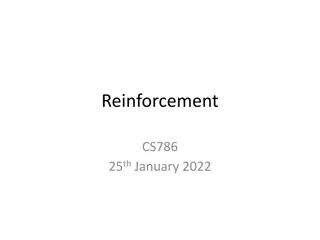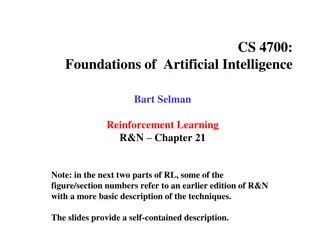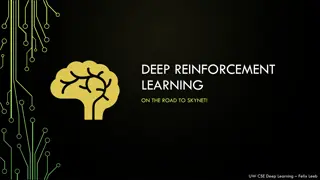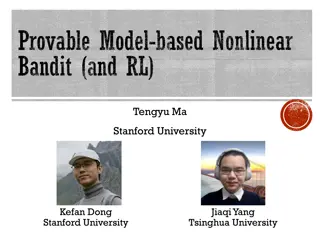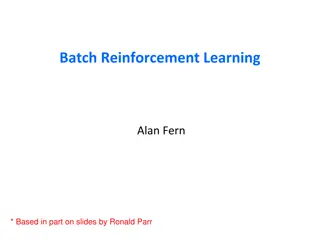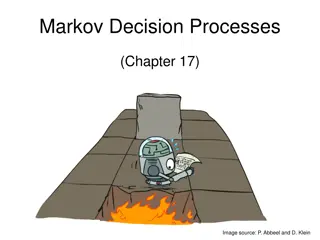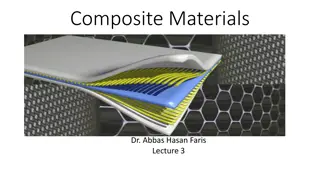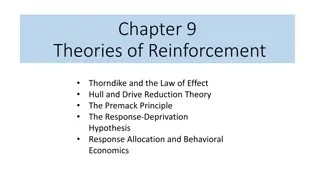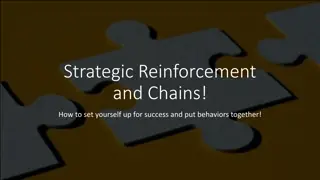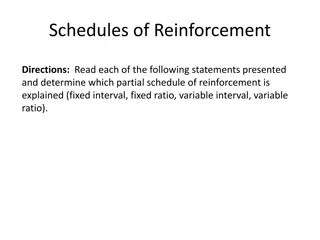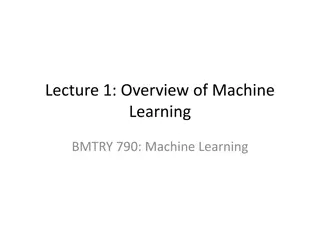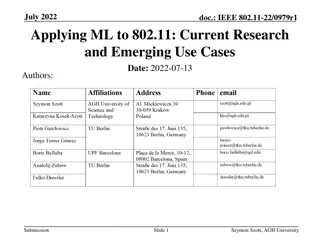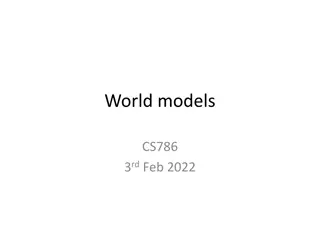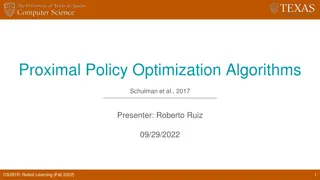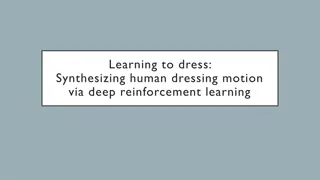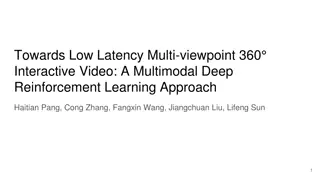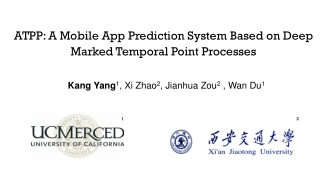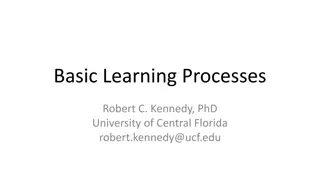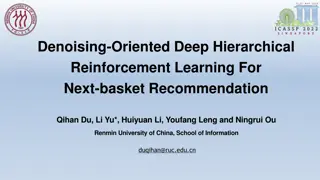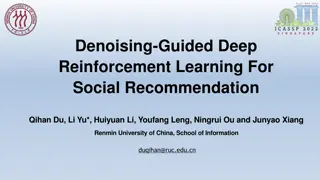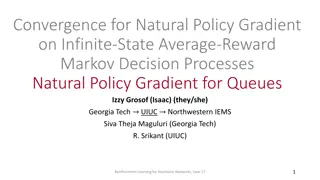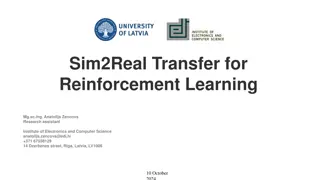Reinforcement Learning
Concepts of reinforcement learning in the context of applied machine learning, with a focus on Markov Decision Processes, Q-Learning, and example applications.
- reinforcement learning
- applied machine learning
- Markov Decision Process
- Q-Learning
- example applications
Download Presentation

Please find below an Image/Link to download the presentation.
The content on the website is provided AS IS for your information and personal use only. It may not be sold, licensed, or shared on other websites without obtaining consent from the author. Download presentation by click this link. If you encounter any issues during the download, it is possible that the publisher has removed the file from their server.
E N D
Presentation Transcript
Reinforcement Learning Applied Machine Learning Joshua Levine
Todays Lecture Markov Decision Process Overview of Reinforcement Learning Q-Learning Example Applications
Reinforcement Learning from Human Feedback (RLHF)
Reinforcement Learning from Human Feedback (RLHF)
Markov Decision Process MDP is defined by: Set of states ? S Set of actions ? ? Transition function ?(?,?,? ) Probability that ? in ? leads to ? : ?(? |?,?) Reward function ?(?,?,? ) A start state Possibly one or more terminal states Possibly a discount factor ?
Policies The policy determines the actions that an agent will take Policies can be deterministic or stochastic The goal of an agent is to learn an optimal policy ? In Deep RL we define the policy with learned parameters ? ??= ??(??)
Discounted Rewards Solving an MDP: maximize cumulative reward Convergence: we use ? to give less weight to samples that are further in the future. This causes the utility to converge Discounted utility: = ? ?0,?0,?1 + ?? ?1,?1,?2 + ?2? ?2,?2,?3 + ? ?0,?0,?1,?1,?2,
Compute Rewards ? ?0,?0,?1,?1, ? ?0,?0,?1 + ?? ?1,?1,?2 + = States: ? = {?,?,?,?,?} Actions: ? = {????,??? ?,????}, and ???? is only valid in states ? and ? Discount factor: ? = 0.1 Start State Reward 10 1 a 10 a b c d e b 1 c 0.1 Policy: d 0.1 e 1 Exit Exit a b c d e
What if we dont know T and R? Usually we don t know the transition probabilities or the reward function The agent needs to learn a policy from the unknown probabilities and reward function
Reinforcement Learning The environment is the world that the agent acts in The agent receives a reward to represent how good or bad the current state is RL: the agent learns to maximize cumulative reward
Value Functions On-Policy Value Function, ??? : expected return starting in state ? acting according to policy ? Q-state Value Function, ??(?,?): expected return if we start in state ?, take ?, then act according to ? ? (?) and ? (?,?) are the optimal functions, used with the optimal policy, ?
Bellman Equations Main Idea: the value of the starting point is the reward for being there plus the value of the next state ? ? = ???? ? ?,?,? [? ?,?,? + ?? ? ] ? ? ?,? = ? ?,?,? [? ?,?,? + ?? ? ] ? = arg max?? (??,?) ??
Model-Free vs Model-Based RL Model-Based: the agent either has access to or learns a model of the environment Often used for games Model-Free: the agent neither learns nor has access to a model of the environment Policy Optimization Q-Learning
Policy Optimization Optimize ??either directly or using gradient ascent on an objective function, which depends on the cumulative reward The optimization is generally done on-policy The policy can only be updated by data from the policy we want to update
Q-Learning Learn an approximator ??(?,?), using the Bellman equation for an objective function Optimization is performed off-policy, the Q-values can be updated using data from any time during training Recall that once we learn the Q-values, our policy becomes: ?(?) = arg max??? (?,?)
Q-Learning Collect samples to update ?(?,?): sample = ? ?,?,? + ?max? ? ? ,? Incorporate samples into an exponential moving average with learning rate ?: ? ?,? 1 ? ? ?,? + ? sample
Q-Learning Collect samples to update ?(?,?): sample = ? ?,?,? + ?max? ? ? ,? Incorporate samples into an exponential moving average: ? ?,? 1 ? ? ?,? + ? sample State Left Right Exit a 0 0 10 b 1 0 - 10 1 c 0.1 0 - a b c d e d 0.01 0 - e 0 0 0 ? = 0.1 ? = 1
Approximate Q-Learning A Q-value table would be too big Represent states with feature vectors Feature vector might include: Distance to nearest ghost Distance to nearest food pellet Number of ghosts Is pacman trapped? Value of Q-states becomes a linear value function We can do the same for state values ? ?,? = ?1?1?,? + ?2?2?,? + + ????? = ? ?(?,?) ?(?,?) is the feature vector for Q-state ?,? ? is a weight vector
Approximate Q-Learning Collect samples to update ?(?,?): ?????? = ? ?,?,? + ?max? ? ? ,? Define Difference: difference = ?????? ?(?,?) Update with learning rate ?: ?? ??+ ? difference ??(?,?) * Note: Exact Q-learning can be expressed as ? ?,? ? ?,? + ? difference
Trade-offs Policy optimization optimizes the thing you want More stable and reliable; less efficient Q-learning can reuse data better because it uses off-policy optimization More efficient; less stable
Training Exploration: explore new states to update approximators Exploitation: rely on approximators for actions Encourage exploration in the objective function or by randomly choosing some actions
Stretch Break Think about: How does reinforcement learning differ from other types of machine learning, such as supervised and unsupervised learning? What are some advantages and disadvantages of reinforcement learning compared to these other types? After the break: Applications of RL
Deep RL: Steps to train an agent 1. Choose or design an algorithm 2. If you are doing deep RL, construct ??which is a deep neural network that can be optimized 3. Define a reward function 4. Start training and tune your reward function as necessary
Hide & Seek Baker et al., 2020 Emergent Tool Use From Multi-Agent Autocurricula
Popular Algorithms Taxonomy of RL Algorithms [Open AI]
Aircraft Controller Soft Actor-Critic Hybrid between policy optimization and Q- learning Actor learns policy while critic learns values Entropy regularization Balancing convergence time and sparse rewards Creating a realistic environment Developing cooperative controllers Simulated Cockpit [Viper Wing]
Additional Challenges Multi-Agent Reinforcement Learning: multiple agents in an environment learn policies and can either compete or cooperate Sim-to-Real Gap: policies in simulation don t usually transfer well to the real world Imitation Learning Source
Additional Challenges Source
Things to remember Markov Decision Process: States, actions, transition probabilities, reward Discounted utility Policy determines actions Reinforcement Learning Agents live in and get rewards from the environment On-policy Value Function and Q-State Value Function Bellman Equations Model-Based vs. Model-free RL Policy Optimization Q-Learning Approximate Q-Learning
References Open AI Spinning Up Introduction to RL UC Berkeley CS188 UIUC CS440


